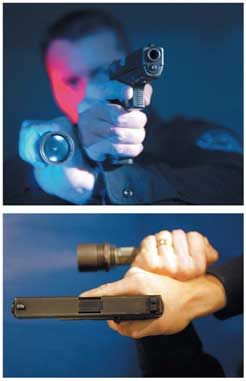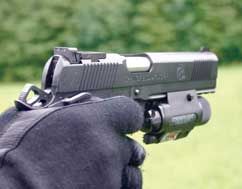Not just a shot in the dark
By John T. Meyer, Jr.
Click here to subscribe to Law Officer Magazine
During a recent meeting of Team One Network instructors, more than 20 of us spent time discussing low-light training, which we agreed is a critical but sometimes short-changed component of officer-survival courses. What follows summarizes what we discussed, our conclusions about how to enhance low-light training and current doctrine dealing with weapon-mounted lights.
Training Truths
 We discovered many of us have been teaching low-light techniques for years. Most started with the FBI technique and then progressed to the Harries. These days, there are more than eight versions of flashlight techniques with many names, but we agreed that no matter how many techniques you try, you must find the one or two that work best for you and stick with them instead of introducing new techniques every time you train. While instructors must know all of the techniques in order to offer various options to their trainees, those officers must find what works best for them and then practice that technique or techniques until they are proficient. Just like shooting skills, consistency and reinforcement are positive and critical factors in officer-survival training. Officers who survive deadly encounters do so because they fight the way they’ve been trained.
We discovered many of us have been teaching low-light techniques for years. Most started with the FBI technique and then progressed to the Harries. These days, there are more than eight versions of flashlight techniques with many names, but we agreed that no matter how many techniques you try, you must find the one or two that work best for you and stick with them instead of introducing new techniques every time you train. While instructors must know all of the techniques in order to offer various options to their trainees, those officers must find what works best for them and then practice that technique or techniques until they are proficient. Just like shooting skills, consistency and reinforcement are positive and critical factors in officer-survival training. Officers who survive deadly encounters do so because they fight the way they’ve been trained.
We also agreed on another issue: As instructors, we must do more that just teach flashlight-shooting techniques. We must teach officers how to operate in low-light conditions, and how to use light and darkness, shadow, silhouette and even “shock and awe” to gain the tactical advantage. While knowing how to shoot a gun with a flashlight is certainly a necessary survival tool, the officer operates in low-light conditions far more than they shoot in low-light conditions.
Weapon-Mounted Lights
In a recent Police1.com survey, nearly half of the more than 1,100 officers polled worked in agencies that allowed the use of weapon-mounted lights. Here’s our take on these tools: The gun-mounted light enhances an officer’s ability to identify and engage a target if the officer has justification/reason to draw their gun in the first place. A gun-mounted light is not an illumination tool; consider it an element of a law-enforcement weapons system.
With that in mind, we strongly recommend that officers who install lights designed to mount on a pistol purchase a holster to accommodate the pistol with the light attached. (The Police1.com poll found that roughly 40 percent of the officers polled who used a weapons-mounted light carried a holster that allowed the light to remain on the handgun.) Many manufacturers make such duty holsters.
We don’t contradict manufacturer’s policies—always verify the weapon is unloaded before you attempt to mount or remove a light. Installing a light on the gun requires fine motor skills. Attempting to do this with the gun loaded could cause the officer to laser themselves, or worse, have an involuntary reflex action and subsequent negligent discharge.
 Furthermore, we also strongly believe it’s impractical and unsafe if you must draw your weapon but then have to unload it in order to install the tactical light. And finally, such holsters address the issue of reholstering as well—being forced to remove your light before holstering hinders your ability to promptly de-escalate a situation and may force you to handle a loaded weapon in a dangerous manner.
Furthermore, we also strongly believe it’s impractical and unsafe if you must draw your weapon but then have to unload it in order to install the tactical light. And finally, such holsters address the issue of reholstering as well—being forced to remove your light before holstering hinders your ability to promptly de-escalate a situation and may force you to handle a loaded weapon in a dangerous manner.
In addition, the justification for drawing and pointing the firearm should not change simply because the officer has a light on the firearm. Officers must still carry both a primary flashlight and a secondary flashlight even if they have a weapon-mounted light, because the time spent using a light as an operational tool far exceeds the time spent firing a weapon with a light. Indeed, similar doctrine has addressed for many years lights mounted on long guns. Having these lights eliminates any concern the officer would have to draw his gun to be able to employ a light.
Again, when mounted to the gun, a light becomes part of a weapons system. Therefore, we must teach our officers to point the light-equipped firearm weapons system in a safe direction at all times, and point the light-equipped firearm at someone only when justified. Once drawn, however, the light-equipped firearm carried at a ready position can and should project sufficient ambient light for navigation.
Officers should also check their firearm for proper operation with a gun-mounted light attached prior to any deployment. In some cases, the additional weight has affected firearm performance, and adding a light may also affect the firearm’s handling characteristics if you don’t train with it attached.
Summary
Most police shootings occur at night. Many officers working nightshift spend a high percentage of their working hours in the dark, and many officers who work dayshift may find themselves searching dimly lit buildings during the middle of the day. But with adequate, realistic training, an additional light will increase the officer’s ability to handle difficult, low-light situations.
Instructors should strive to provide realistic training scenarios that give students experience they can use in the field. The bottom line: Gun-mounted lights will aid identification and enhance the officer’s tactical ability, which in turn will increase the safety of officers and the public they serve.
John T. Meyer Jr. is president of Team One Network, LLC, a company established to test, evaluate, train and market various manufacturers’ officer survival-related products. Meyer spent 15 years with Heckler & Koch, Inc., and was a lieutenant with the DOD Police, where he served as a special reaction team leader. He is vice president of the International Association of Law Enforcement Firearms Instructors, a member of the Policeone.com advisory board and the Police One Training Network, and a member of the American Society of Law Enforcement Trainers Firearms Committee.


